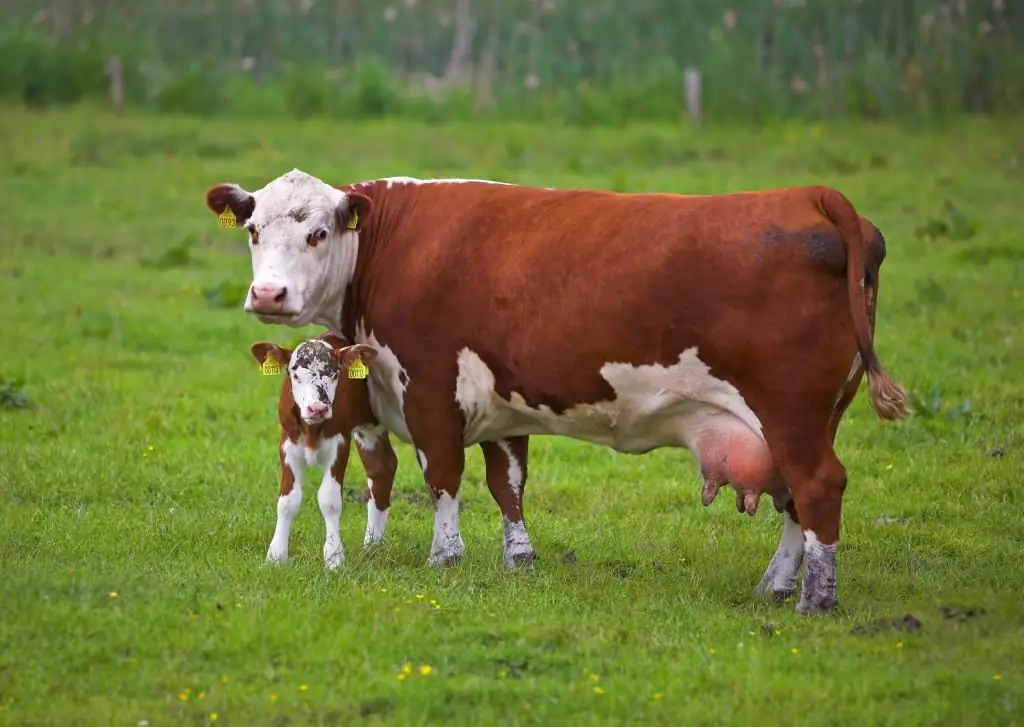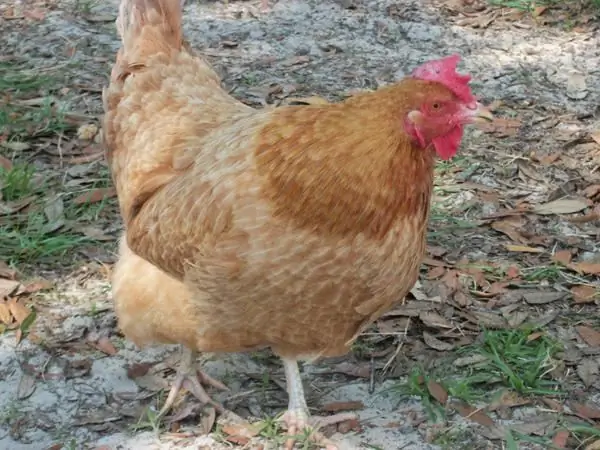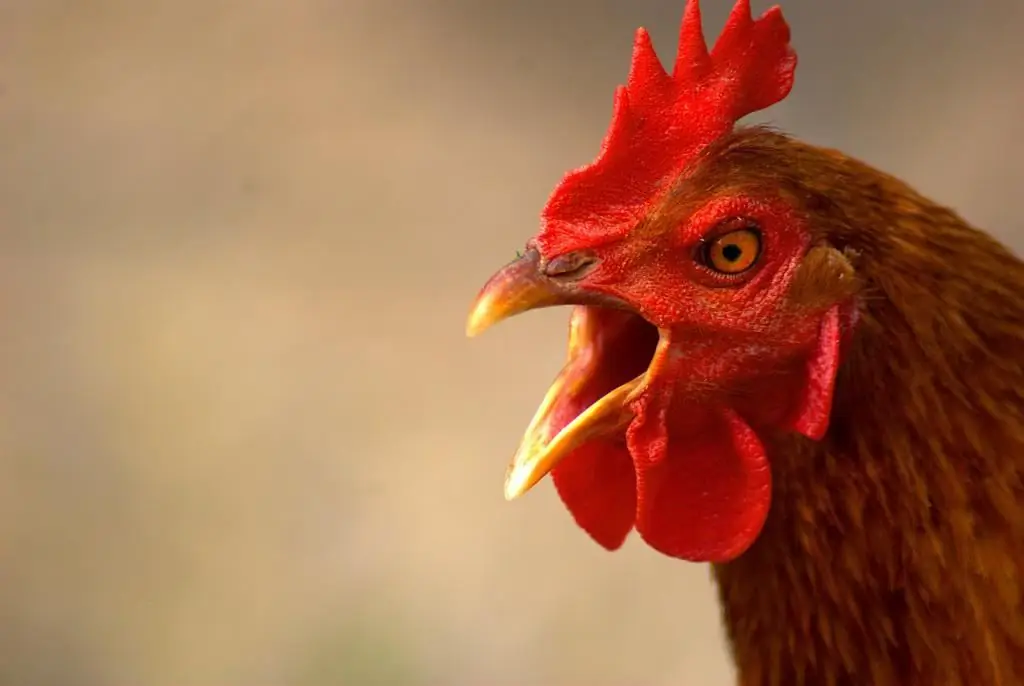2025 Author: Howard Calhoun | [email protected]. Last modified: 2025-01-24 13:10:39
Eimeriosis of chickens affects mainly young birds. Without treatment, chickens either die or become carriers for life, which causes material damage to the farm. The biology of the development of eimeriosis in chickens can be different, because 9 pathogens can cause the disease at once. If an infection is detected, it is necessary to improve the economy.
Historical background
The first data on Eimeriosis of chickens date back to the 18th century. In 1891, a mass death of chickens from this disease was registered. The same parasite was found in the cecum of the dead bird. Later, scientists conducted the first experimental infection of young chickens. In the Soviet Union, scientists Yakimov and Galuzo took up the study of the disease.

Pathogen
Eimeriosis in chickens is caused by nine types of protozoan unicellular organisms. But most often, veterinarians have to deal with four of them. Pathogens have a complex development cycle, the first part of which occurs in the body of a bird, whereoocysts are formed. After a while, they are released into the external environment. If the temperature and humidity are favorable, the oocytes will be activated. They will be able to infect birds and animals that swallow them.
In the presence of an optimal amount of oxygen, favorable humidity and a temperature of 18 to 29 degrees, oocytes become infective in 2-4 days. After they enter the digestive tract of the bird and begin to parasitize there. Their shell is damaged, and sporozoites are born. They are able to invade epithelial cells and multiply in them, which is what parasites do. From one oocyte in just a week, up to 2 million pathogens of chicken eimeriosis can appear. The most common disease occurs in young birds under the age of 180 days.
Epizootological data
Eimeriosis in chickens and rabbits is diagnosed by veterinarians in all regions of Russia. The disease is no less common in other countries. The pathogens are resistant to adverse environmental conditions. They also have good reproduction ability.
In small private households, outbreaks are most common in spring, summer and early autumn. This is because at these times of the year the temperature and humidity levels are most favorable for the reproduction of eimeria. Moreover, during the warmer months of the year, farmers are more likely to breed chickens that are most susceptible to disease.
Seasonality is not so pronounced at the poultry farm. Birds kept in crowded conditions have a higher chance of contracting Eimeriosis. Dampness in the room and improperfeeding can further exacerbate the disease situation in chickens.

Description of the disease
Eimeriosis in chickens is an infection that mainly affects young animals. This disease is also called coccidiosis. The causative agents of eimeriosis parasitize in the intestines of animals and birds. Mostly chickens aged 10-15 to 180 days get sick.
Incorrect feeding of birds increases the likelihood of an epidemic. Vitamin deficiency is especially dangerous. The causative agents of eimeriosis love damp, warm and unsanitary conditions. Of particular danger are winter deep litter, which do not change for months. A sick bird becomes lethargic, constantly lies and loses interest in the world around it. Chickens stop eating, lose a lot of weight, and often they have a violation of the stool. Some individuals may experience seizures.
Immunity
Birds of all species and breeds are susceptible to the disease. But at the moment, there have been too few studies aimed at identifying immunity to eimeriosis in individual chickens. It is known that in the acute form the disease is most often carried by chickens at the age of 10 days. Adult birds are usually carriers and appear clinically he althy. For example, chickens suffering from eimeriosis in the photo do not differ from uninfected ones.
It turns out that their immunity depends on the presence of a pathogen in their body. In the blood of sick birds, antibodies are formed, which makes them immune to repeated infections. This discovery made it possible to develop methods of immunization,in which oocytes exposed to radiation are used.

Incubation period for disease development
Most often at first the disease proceeds in an asymptomatic form. Usually the incubation period takes from 3 to 15 days. There are 3 forms of the course of eimeriosis: acute, subacute and chronic. The first two are more typical for chickens, and the last one is more typical for adult chickens.
The timing of symptoms depends on the type of pathogen infecting the bird. Also important is the age of the animal and its immunity. Depleted individuals receiving poor nutrition succumb to disease more quickly. Also in this situation, the presence or absence of other chronic diseases plays a role.
Distribution routes
The main route of infection for birds is contact with infected individuals. Also, a deep litter or seeded inventory is a danger. It has been observed that if chicks are released into a brooder that contains contaminated items, then eymeriasis is diagnosed after about 2 weeks, occasionally after a month. After 45-60 days, if the chickens have not died, they develop immunity. These individuals no longer suffer from acute hen eimeriosis, their symptoms disappear, they become lifelong carriers.
You can keep chickens in personal brooders from the first days and prevent contact between different groups. In this case, when infected at the age of 1.5-2 months, they fall ill on the 5-10th day. By the 20th day without treatment, the infection reaches its maximum.

Symptoms
Manifestations of eimeriosis may differ depending on the form in which the disease proceeds. The clinical signs are especially pronounced in chickens under the age of 2 months. In chicken eimeriosis, symptoms and treatment differ depending on the age of the bird. In the acute form, chickens become drowsy, inactive, lethargic. Almost all the time they either lie or sit with lowered wings. Chickens refuse to eat and drink a lot.
This is due to the fact that the parasite has disturbed the function of digestion. The bird is getting toxic. Metabolism is disturbed, anemia occurs. Affected individuals begin to group together, their feathers become dull and ruffled. In the litter, the owner can detect a bloody admixture. The wattles and comb of affected chicks become whitish in color. In some chickens, convulsions occur, damage to the central nervous system occurs. Without treatment, most birds die.
Diagnosis
Eimeriosis of chickens is caused by unicellular microorganisms. A veterinarian can diagnose this disease both in vivo and posthumously. Feces are examined according to the Darling or Fülleborn method. They also make swabs, scrapings from the intestines. If the bird has already died, then the diagnosis is made posthumously. A fallen chicken is examined for scrapings from the intestinal mucosa.
If it is impossible to take tests to the laboratory, then the veterinarian makes a diagnosis based on the clinical picture. To do this, he takes into account the conditions of keeping the bird, its age, season. When making a diagnosis, it is important not to confuse eimeriosis with othersimilar diseases: histomonosis, spirochetosis, pullorosis.

Patological changes
The bodies of dead chickens show signs of exhaustion. The feathers near the cloaca are dirty, they have traces of liquid feces and litter adhering to them. The presence of blood impurities is possible. The crest and wattles of affected individuals are whitish in color. Mucous membranes are either pale or bluish.
The most noticeable changes in internal organs. The stomach and goiter do not contain food, it is possible to find mucus in them. The walls of the duodenum are thick, inflamed, swollen. There are grayish nodules and petechial hemorrhages. The same picture is observed in the intestine. Ulceration of the serosa is also possible.
Treatment
The choice of therapy is determined by the veterinarian and depends on the form of the disease. What chemotherapy drugs are used in the treatment of chicken eimeriosis? Pharmkoktsid, Lerbek, Koktsidiovit. In no case should you self-medicate, as Eimeria eventually adapt to the drugs, and they no longer act on them.
Zoalen has proven itself well, it is given to chickens at the rate of 200 g per 1 ton of grain mixture. Eimeriosis can also be treated with sulfa drugs. For prevention, give "Ardilon" at 0.05 ml per 1 kg of feed. In order for the eimerias not to have time to adapt to the drugs, the funds must be periodically alternated.

Prevention
To improve the economy as a whole, measures must be taken. Young growth is desirable to keepseparate from adult birds. Crowding, poor ventilation, drafts, dampness should not be allowed. Until the chicks are 60 days old, they are kept on a mesh floor. Litter must be removed in a timely manner. If the bird is sick in an acute form, then you need to immediately begin the treatment of eimeriosis in chickens.
In broiler farms, when there is a threat of mass infection of chicks, chemical prophylaxis is used. Doses should be adjusted by a veterinarian in such a way that they do not affect the natural production of immunity.
The vaccine that has recently been used in some farms has proven itself well. It was recommended by the All-Russian Research Veterinary Institute of Poultry. The vaccine is used in farms that are unfavorable for eimeriosis. Chickens are simultaneously injected with a drug containing a large number of pathogens. At the same time, they are treated according to the regimen for eimeriosis, which does not interfere with the formation of their own immunity.
What other animals suffer from eimeriosis?
This disease is found in both animals and birds. Eimeriosis can occur in both acute and chronic forms. Lambs aged from 1 to 2 months are most often infected with it. Eimeriosis is severe in small calves, but animals from six months tolerate it asymptomatically. In untreated rabbits, mortality from this disease can be as high as 100%.
Of animals, pigs, minks, arctic foxes, goats are also susceptible to the disease. Birds susceptible to eimeriosis are ducks and geese. Moreover,the latter, all pathogens are localized in the renal epithelium. There are cases of eimeriosis in cats and dogs.

Danger to humans?
There is no single answer to this question. Some doctors admit the possibility of human infection through food and water. However, parasitologists say that no cases of human infection with eimeriosis have been recorded.
Vet advice
In order to prevent an epidemic of eimeriosis in your household, you must follow basic hygiene rules. If there are few birds on the farm, then if they are properly kept, the disease will not be able to penetrate the farmstead.
Any bird entering the farm must be quarantined. This will help protect the farm not only from eimeriosis, but also from other dangerous diseases. Chickens need to be settled in another room and not allow any contact with their own bird. Purchased individuals should have their own care equipment, their own bowls, their own feeders. Caring staff before entering the barn, in which the chickens are in quarantine, must change shoes or put on shoe covers. This is done so that workers do not spread a possible infection throughout the farm.
If there are a lot of birds on the farm, then they are usually given prophylactic drugs that do not interfere with the development of natural immunity. The dosage regimen should be drawn up by a veterinarian. The disease has several variants of the pathogen, so the remedies recommended by friends or acquaintances may turn out to beineffective.
Recommended:
Cattle piroplasmosis: etiology, causes and signs, symptoms and treatment of cattle

Most often, outbreaks of piroplasmosis are recorded in the spring-autumn season. Cows go out to pastures where they encounter infected ticks. The disease is transmitted through the bite of a parasite and can cause a decrease in herd productivity. In some cases, the death of livestock occurs. To prevent economic losses, it is necessary to carry out preventive measures
Fruit rot: causes, first signs and symptoms of infection, methods of treatment and improvement of the garden

It happens that the gardener does not have time to collect the fruits - they rot right on the branches and fall off. At the same time, in appearance, apples and pears look quite he althy, but from the inside, an insidious enemy of all stone fruit and pome crops lurks - fruit rot. Despite the fact that this dangerous adversary is well studied and can be defeated, amateur gardeners often do not notice signs of infection in the early stages of the disease
Kuchinsky anniversary chickens. Meat chickens. Egg breeds of chickens

Poultry farming has been extremely popular with our peasants since ancient times. Chickens and ducks required little care, in the summer they found food on their own, and the eggs and meat received from them were a valuable source of protein, which was so necessary in a difficult rural lifestyle
Cannibalism in chickens: causes and treatment. Features of keeping chickens

Cannibalism in chickens is a rather creepy sight that can scare even an experienced farmer. Of course, this brings serious losses to any economy. Therefore, it is especially important to know how to act in such a situation in order to quickly solve the problem
Eimeriosis of rabbits: causes, symptoms, treatment methods

Eimeriosis, or coccidiosis, is the most common invasive disease of young rabbits that damages the digestive organs. Mortality among young animals reaches almost one hundred percent. Most often, rabbits are exposed to the disease from one to five months. Due to eimeriosis, many farms are closed and the number of animals is significantly reduced

